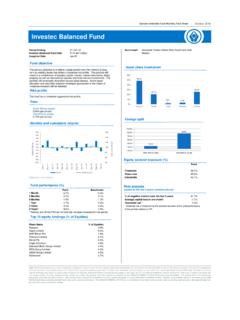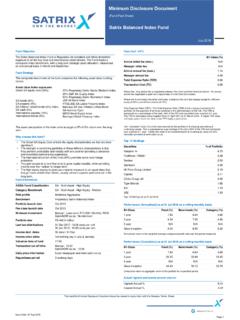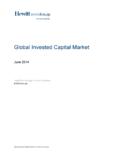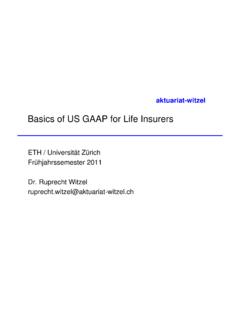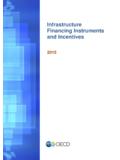Transcription of Sanlam Select Absolute Fund
1 Fees (Incl. VAT)LISP-class (%)Advice initial fee (max.) initial fee (max.) annual fee (max.) annual fee (max.) Expense Ratio (TER) is a flexible asset allocation fund which aims to deliver positive real returns by targeting CPI+5% over a rolling 3 year period whilst actively managing downside risk and minimising risk of capital loss over the medium term. The fund is managed in accordance with Reg. 28 ObjectiveThe fund invests in a combination of equities, money market instruments; nominal and inflation linked bonds and listed property as well as international equities and fixed interest investments. The Fund manager employs an active asset allocation and securities selection strategy which is derived from a strong risk management framework. The Fund targets not to lose capital over any rolling 12 month period and is Regulation 28 compliant. The investment manager will also be allowed to invest in financial instruments (derivatives) as allowed by the Act from time to time in order to achieve its investment Strategy This fund is less volatile than a traditional balanced fund with greater focus on capital preservation.
2 By investing in a single fund that diversifies across all major asset classes, investors outsource the difficult decision on how much and when to invest in various asset classes. The small Assets Under Management (AUM) of the manager means that the manager is very nimble and able to execute ideas quickly and react speedily to changes in market conditions. Strong risk management focus enhances capital preservation choose this fund?Fund InformationASISA Fund ClassificationSouth African Multi Asset FlexibleRisk ProfileModerateBenchmarkCPI+5% over a 5-year rolling periodFee Class Launch date*01 September 2014 Portfolio Launch date02 December 2013 Minimum investmentLISP minimums applyPortfolio SizeR 641 millionBi-annual Distributions30/06/18: cents per unit31/12/17: cents per unitIncome decl. dates30/06 | 31/12 Income price dates1st working day in January and July*Portfolio valuation time15:00 Transaction cut off time15:00 Daily price informationThe local newspaper and period3 working daysAdvice fee | Any advice fee is negotiable between the client and their financial advisor.
3 An annual advice fee negotiated is paid via a repurchase of units from the a personalised cost estimate before investing by visiting and using our Effective Annual Cost (EAC) calculator. Alternatively, contact us at 0860 100 fund is available via certain LISPS (Linked Investment Service Providers), which levy their own Performance Fee (incl. VAT) | Performance Fee Benchmark: Morningstar Category Average for the ASISA Fund Category SA MA Medium Equity, Base Fee: , Fee at Benchmark: , Fee hurdle: Morningstar Category Average for the ASISA Fund Category SA MA Medium Equity, Sharing ratio: 20%, Minimum fee: , Maximum fee: , Fee example: if the fund performs in line with its Performance Fee benchmark being Morningstar Category Average for the ASISA Fund Category SA MA Medium Deviation (Ann) Ratio (Ann) 10 Equity HoldingsPerformance (Annualised) as at 31 Jul 2018 on a rolling monthly basis*LISP-classFund (%)Benchmark (%)1 YearN/AN/ASince annualised rate of return is the average rate of return per year, measured over a period either longer or shorter than one year, such as a month, or two years, annualised for comparison with a one-year (Cumulative) as at 31 Jul 2018 on a rolling monthly basis*LISP-classFund (%)Benchmark (%)1 YearN/AN/ASince return is the aggregate return of the portfolio for a specified period.
4 *Significant changes to this fund came into effect from 01 September 2014 and all performance figures are calculated from this date and not the original fund launch statistics: 3 years to 31 Jul 2018 Highest Annual % Annual % highest and lowest annual returns*The performance fee is accrued daily, based on performance over a rolling 12 month period with payment to the manager being made monthly. Performance fees will only be charged once the performance fee benchmark is outperformed and only if the fund performance is positive. A copy of the performance fee FAQ is available on : 1 April 2015 to 31 March 2018 Total Expense Ratio (TER) | of the value of the Financial Product was incurred as expenses relating to the administration of the Financial Product. A higher TER does not necessarily imply a poor return, nor does a low TER imply a good return. The current TER may not necessarily be an accurate indication of future TER s. Inclusive in the TER of , a performance fee of of the net asset value of the class of Financial Product was Cost (TC) | of the value of the Financial Product was incurred as costs relating to the buying and selling of the assets underlying the Financial Product.
5 Transaction Costs are a necessary cost in administering the Financial Product and impacts Financial Product returns. It should not be considered in isolation as returns may be impacted by many other factors over time including market returns, the type of Financial Product, the investment decisions of the investment manager and the TER. Total Investment Charges (TER + TC) | of the value of the Financial Product was incurred as costs relating to the investment of the Financial 10% of EquityVanguard Total World American Tobacco Europea Corporation Billiton *Performance figures sourced from date: 22 August 2018 This monthly Minimum Disclosure Document should be viewed in conjunction with the Glossary of Terms Select Absolute FundJuly 2018(Fund Fact Sheet)After a tumultuous second quarter, the northern-hemisphere summer and improved valuations brought a welcome stabilisation in capital flows. But this stability belies the growing discomfort with the escalating trade frictions between the US and China.
6 The trade war will in the end be harmful to the global economy, but the politics of the day point to ongoing tariff action, at least until the US mid-term elections in November. Trump s approval rating has climbed from a low of 37% in December to 43%, while the ascent in the S&P 500 Index shows there is, as yet, little to dissuade the US from changing of a change in the Bank of Japan s yield curve control lifted the 10-year Japanese government bond yield to a two-year high of a mere blip on a long-term chart, but enough to steepen the US yield curve and push the US 10-year yield above 3%. Shifting fundamentals weakening growth, eroding interest rate differential, and a deteriorating balance of payments position triggered substantial depreciation in the Chinese Yuan. This gave rise to speculation that China is responding via exchange rate policy and so risks sparking another round of US seems that the only certainty is that the Federal Reserve will follow through on its dots, with a 25 basis points (bps) hike in September fully priced in by the market.
7 The ongoing US/Rest of World growth divergence has intensified expected monetary policy divergence, keeping the Dollar on the front foot. While a strong Dollar is a challenge to emerging market (EM) growth, some reprieve comes from the lower oil leaves the Rand as the main risk to the inflation outlook. The July Monetary Policy Committee statement reflects this risk, but it was not alarmist, and the SA Reserve Bank (SARB) s revised CPI forecast builds in a reasonable buffer to allow for ongoing downside inflation surprises. As long as second-round effects remain absent, the SARB will be able to keep the repo rate unchanged. The local data point to a modest improvement in sequential GDP momentum in Q2, but growth above is a tall order given external headwinds. President Ramaphosa s investment drive is gradually accelerating, but absent detail on timelines and funding it should not be discounted into baseline GDP forecasts just yet. Confidence will remain depressed until there is policy clarity, particularly the ANC s decision to circumvent the Constitutional Review Committee in amending Section 25 of the Constitution to explicitly incorporate expropriation without compensation.
8 While the devil is in the details, until it is finalised the uncertainty about property rights is more than likely to delay the much-needed fixed investment and the recovery in potential GDP developments Local fixed income moved back to poll position, with the FTSE/JSE All Bond Index (ALBI) returning , followed by fixed-rate credit ( ), cash ( ), floating-rate credit ( ) and inflation-linked bonds ( ). Property ( ) and equities ( ) were the underperformers during US Dollar Index (DXY) rose only in July, which suggests that Dollar-supportive expectations are already in the price. The range-bound greenback allowed EM FX to recover, with the Rand gaining against the US Dollar, making it one of the better performing currencies during the month. At the Rand is around 5% undervalued relative to our fair-value range and is trading wide relative to SA s credit default swap spread. Investment Manager Monthly CommentaryAsset AllocationAppointed Investment ManagerMatrix Fund Managers (Pty) LtdThe US 10-year yield remains in a core range with the recent upward pressure coming from the shift in the demand/supply balance due to the funding of the US budget deficit, as well as monetary policy tweaks in Japan.
9 SA rates rallied by bps during July amid a downside inflation surprise, the rebound in activity data, improving trade balance, and steady fiscal position. After the Q2 flight of the tourist Dollar, net portfolio inflows into SA bonds recovered by a modest billion in July. The SA 10-year yield is trading moderately cheap versus our fair value estimate of the recovery in EM equities amid the Europe/US trade truce, the lower oil price, and stronger EM FX, they nevertheless underperformed developed markets (DM) the MSCI World Index rose by versus the MSCI EM Index return of The MSCI South Africa Index rose by 5% in Dollar terms, with the bulk of the gains due to the stronger Rand. The FTSE/JSE All Share Index lost while the FTSE/JSE Shareholder Weighted Index (SWIX) eked out a gain in Rand terms. Increases in life insurance ( ), banks ( ), and telecommunications ( ) were countered by the decline in media ( ). While the industrial and resources sectors lost 2% and , respectively, the constituent counters posted mixed returns as sector- and company-specific factors dominated in a broadly sideways market.
10 The MSCI South Africa Index forward price-earnings ratio (P/E) edged upwards to times as earnings expectations declined slightly. Non-residents sold a mere billion of equities in July, according to the JSE performance and positioningThe fund s positive performance ( ) was driven by bonds ( contribution), domestic negotiable certificates of deposit and cash ( ), and local equity ( ). These were partly countered by the detraction from foreign equity ( ), foreign cash ( ), and property ( ).The fund remains conservatively positioned for risk, as reflected by our domestic cash position (27%), equal weight-duration position in bonds (28%) via investments in high-yielding low-duration credit instruments and government bonds, and defensive local equity allocation (29%). We have a small holding in foreign equity (9%), with a higher weighting in Europe where we believe the earnings growth prospects are more favourable than the rest of DM given the stronger GDP recovery.



